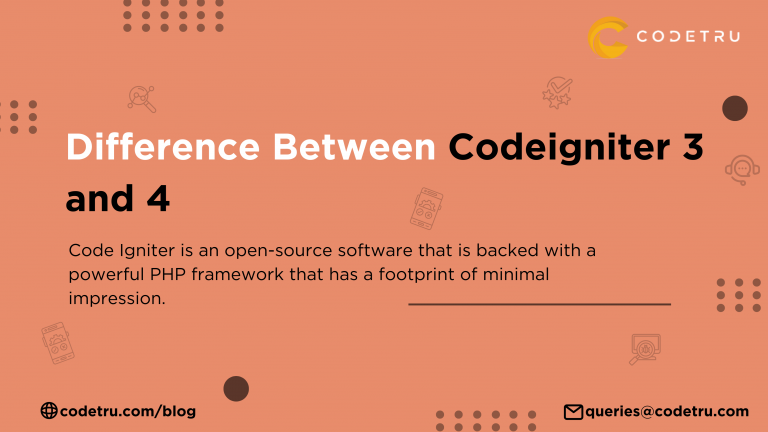The Challenge
Before we know the difference between Codeigniter 3 and Codeigniter 4 let’s have a little background of what Codeigniter is and also look at their uses. Code Igniter is an open-source software that is backed with a powerful PHP framework that has a footprint of minimal impression. This framework is said to be beneficial for web developers, who can use this simple yet powerful toolkit to design full-fledged web applications. Code Igniter is said to have derived inspiration from the model-view-controller.
Benefits of Code Igniter
1. Powerful Performance
Codeigniter is a nightmare for its competitors. Its consistency and quality are the main highlights that make it a clear winner.
2. Solid Securtiy
The CodeIgniter is an efficient model that provides solid security with inbuilt protection against CSRF and XSS attacks.
3. Zero Configuration Model
The configuration of CodeIgniter is a conventional model where the models are put in the ‘models ‘folder. Many other configuration models are found available in its ‘config’ folder.
4. Simple solutions, No Complications
The best benefit of the CodeIgniter is that it encourages MVC and it doesn’t force this concept on anyone.
5. Perfect Documentation
CodeIgniter provides a clean and net documentation process without losing any information making it highlight feature and a threat to most of its competitors.
Knowing Code Igniter 3 and Code Igniter 4
Code Igniter 3 was the date’s choice of all PHP developers which is used with PHP 5.6+
Code Igniter 4 is an updated version or a recreation of the framework of Codeigniter 3. This system is reliable and also is compatible
Difference between Code Igniter 3 and 4?
1- Support for PHP versions
CodeIgniter 4 functions on the PHP version of 7.2, while the CodeIgniter 3 can function on the version 5.6. The 5.6 is quite outdated and a few of them have been discontinued already.
2- Application Structure
The structure of the application and its folder is different here. The folder is now named as an app and the framework still has system folders, with the same kind of interpretation as the earlier one. The present framework has provision for a public folder, which is treated as the root document for your app.
There is a folder it is called the writable folder that can hold cache data, logs, and session data. The app folder has few similarities to that of CI3 where in there are few name changes, and some subfolders moved to the writable folder. As there is a unique mechanism for extending framework components, there is no requirement for a long nested application or the core folder.
3 — Use of namespaces
Namespaces are used lavishly in CodeIgniter 4 which is written in PHP7 in comparison to CodeIgniter 3 which hardly or doesn’t use these namespaces at all.
4 — Class Loading
The ‘super object’ titled CodeIgniter may not be available further with the framework component which is administered as controller properties Classes are instantiated where needed, and components are managed by Services. The class loader efficiently manages the PSR$ style class without any assistance within the Application (APP) and CodeIgniter (System) which are considered the prominent namespaces. This working capacity of the class loader is compatible with auto-loading support and is also is making use of the educated to know and find your libraries and models to see if they are allocated in the correct folder even if it is not namespaced.
5 — Controllers
Controllers extend \CodeIgniter\Controller instead of CI_Controller. To invoke CI and its craft the constructor is not used any more, until and unless you are using it as part of base controller that you are making. The advantage of CI is that it helps you with the request and response objects which are considered as powerful as the CI3-way You can create a base controller as you wish and where you would like it to be (My Controller in CI3)
e.g. Base Controller extends Controller and then you can extend them using the controllers that you have got.
6- Models
Models extend \CodeIgniter\Model instead of CI_Model. The CI4 model is widely popular because of its inbuilt qualities and functionalities like automatic database connection, CRUD that is basic and raw, automatic pagination, and in-model validation. If you wish to have richer data mapping for your database tables you can make use of CI4 which has the entity class which will help you serve your purpose. CI3’s $this->load->model(x) would now have become the older version $this->x = new X(); will be used now which is followed by the namespaced conventions for your component.
7-Views
Though this component of your views looks much like the ones used before, but these are invoked differently. CI3’s $this->load->view(x) was the older one, instead of it you can use echo view(x); CI4 helps or assists you to view “cells”, to build your response in pieces The template parser is still exists but with minimal enhancement.
8– Performance
CodeIgniter 4, is popular for its performance unlike CodeIgniter 3 which uses PHP 7 in writing and as a minimum configuration on the server.
9 — Libraries
Though Your app classes have the option to go inside app/Libraries, they don’t necessarily have to choose this, Instead of CI3’s $this->load->library(x); one can now use $this->x = new X(); followed by the name spaced conventions for your component.
Though Your app classes have the option to go inside app/Libraries, name spaced don’t necessarily have to choose this, Instead of CI3’s $this->load->library(x); one can now use $this->x = new X(); followed by the namespaced conventions for your component.
10-Downloads
For downloads, CI4 is still available as a ready-to-run zip or tarball with the user guide. Composer can also be used for the installations.
FAQs on CodeIgniter 3 vs. CodeIgniter 4
1. What are the main differences between CodeIgniter 3 and CodeIgniter 4?
In comparing CodeIgniter 3 and CodeIgniter 4, the key differences lie in their PHP version support, application structure, use of namespaces, class loading mechanisms, and overall performance enhancements. CodeIgniter 4 requires PHP 7.2 or higher, introduces a revamped folder structure with a focus on the “app” and “writable” directories, extensively utilizes namespaces for improved code organization, adopts a modern PSR4 class loading approach, and promises better performance optimizations over CodeIgniter 3.
2. What are the key differences in PHP version support between CodeIgniter 3 and 4?
CodeIgniter 3 supports PHP 5.6, which is now outdated and discontinued. CodeIgniter 4, on the other hand, requires PHP 7.2, ensuring compatibility with more recent and secure PHP versions.
3. How has the application structure changed from CodeIgniter 3 to CodeIgniter 4?
CodeIgniter 4 introduces a new folder structure with an “app” folder and a “writable” folder for cache data, logs, and session data. It also includes a public folder treated as the root document for your app. This is a significant shift from the structure in CodeIgniter 3.
4. What is the role of namespaces in CodeIgniter 4 compared to CodeIgniter 3?
CodeIgniter 4 extensively uses namespaces, written in PHP 7, which enhances the organization and management of code. In contrast, CodeIgniter 3 rarely uses namespaces, making CI4 more modern and efficient.
5. How has the approach to class loading changed in CodeIgniter 4?
CodeIgniter 4 uses a more efficient PSR4 style class loader, managing classes through Services and not relying on the “super object” approach of CodeIgniter 3. This change improves auto-loading support and simplifies class management.







